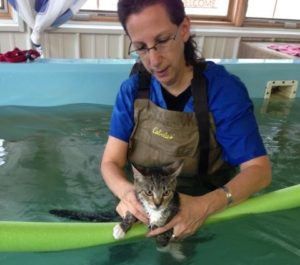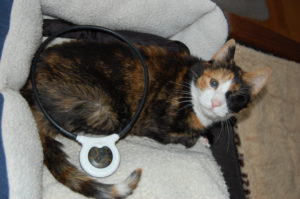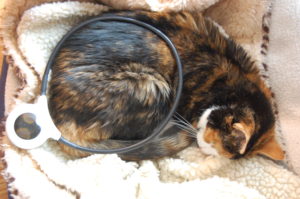Lyn Garson

Lyn Garson is a Certified Veterinary Technician with 34 years of experience in general practice. She currently works as a Canine Rehabilitation Practitioner. Although not limited to canines, she has a special interest in physical rehabilitation for felines as well. Lyn is also a founding member and Administrative Officer of the National Veterinary Response Team (NVRT) where she manages a team of over 125 veterinarians and technicians. NVRT is the primary federal resource for veterinary medical support during disasters and national special security events. A professional member of the National Cat Writers™ Association, Lyn is the recipient of multiple Muse Medallion awards for her writing and Technically Speaking column published in Our Companions News.
 I admit I was skeptical. After all, how could a disposable, plastic, battery-operated Loop miraculously alleviate pain and inflammation in animals without using drugs? I read the clinical research studies, many building on data from related human medical trials, and heard of amazing results through my fellow veterinary physical rehabilitation colleagues. Then, while attending a conference, I decided to check out the intriguing Assisi Loop® myself. Although completely unaware at the time, that purchase no only convinced me of the device’s treatment merit but ultimately led to saving my own cat’s life.
I admit I was skeptical. After all, how could a disposable, plastic, battery-operated Loop miraculously alleviate pain and inflammation in animals without using drugs? I read the clinical research studies, many building on data from related human medical trials, and heard of amazing results through my fellow veterinary physical rehabilitation colleagues. Then, while attending a conference, I decided to check out the intriguing Assisi Loop® myself. Although completely unaware at the time, that purchase no only convinced me of the device’s treatment merit but ultimately led to saving my own cat’s life.
The Loop
According to their website, the Assisi Loop is an FDA cleared Non-Pharmaceutical Anti-inflammatory Device (NPAID®).
In both humans and animals, an NPAID is a class of medical devices that employs a form of electromagnetic therapy for animals, treating a variety of orthopedic, neurologic or degenerative issues, post-surgical pain, and swelling, inflammation, and open wounds.
The Assisi Loop utilizes tPEMF (targeted Pulsed Electro-Magnetic Field) technology to stimulate the body’s natural healing response.
Pain, swelling, and inflammation are reduced by enhancing the therapeutic production properties of nitric oxide in tendons, ligaments, bones, inflamed skin, and internal organs. The device is placed over an area to be treated for a 15-minute interval. Pets may feel a slight pleasantly warm sensation due to increased blood circulation and often enjoy being held during therapy as many quickly make a connection between treatment and relief.
Positive results may be seen in as little as one or two sessions, while chronic cases can require up to two weeks for noticeable improvement. The Assisi Loop is available for at-home use either dispensed through your veterinarian or animal physical rehabilitation practitioner as part of a continued treatment plan or online directly from Assisi Animal Health with a veterinary prescription.
Pets in Pain
 Since they can’t speak for themselves, what is the best way to determine when pets are in pain?
Since they can’t speak for themselves, what is the best way to determine when pets are in pain?
Generally, human pain perception is similar to an animal’s, so if an ear infection is excruciating for you then it will most likely be for your pet. Typically, pets won’t cry out unless in severe or acute pain.
Instead, they deviate from their normal routines. Especially in cats, special attention to unusual behavior, vocalization, body position, and gait can provide clues to pain.
Take note of these signs:
- Panting, trembling or shaking
- Growling, hissing, or even purring
- Increased sleeping or hiding
- Unwillingness or inability to move or walk
- Restlessness or pacing
- Failure to groom
- Decreased or absent appetite
- Inappropriate elimination outside the litter box
- Guarding a specific body area
- Flattened ears, hunched back or tucked abdomen
- Limping, stiffness or avoiding stairs
This list is certainly not exhaustive but simply a guideline. Take note that some signs may suggest an anxious or stressed pet, or one experiencing other medical issues.
Looping Noodle
 It is particularly important not to dismiss older pets’ issues simply as natural consequences of aging.
It is particularly important not to dismiss older pets’ issues simply as natural consequences of aging.
Senior pets may desire engaging in playtime, only to find excessive movement too painful. Diminishing function and mobility may indicate a progressive disability, however, once the pain is appropriately managed, overall activity levels may increase, even reverting back to that of younger years.
As for my own cat, 20-year- old one-eyed Noodle, the Assisi Loop literally saved her life. Noodle’s symptoms of spinal osteoarthritis improved significantly after only four days of daily Loop treatments.
The true test, however, presented itself weeks later when Noodle suddenly stumbled into the kitchen howling and panting and then collapsed. Emergency x-rays confirmed the previously diagnosed osteoarthritis, however, no disorders were found within her heart, lungs, or elsewhere.
Her blood tests also revealed no life-threatening abnormalities and yet there she was, seemingly on death’s door, unable to eat or move. Considering Noodles adverse reactions to various pharmaceuticals in the past, I prepared for the worst, struggling to decide if it might be time to say goodbye. As a last-ditch effort that night, I treated her numerous times with the Assisi Loop.
 Amazingly, the very next morning, Noodle sat up and ate all her food. Within one week of the event, she not only resumed her normal routines but even played chase with a ball and leaped off the cat tree!
Amazingly, the very next morning, Noodle sat up and ate all her food. Within one week of the event, she not only resumed her normal routines but even played chase with a ball and leaped off the cat tree!
The American Animal Hospital Association (AAHA) and the American Association of Feline Practitioners (AAFP) both updated their guidelines last year, embracing advances in pain management by incorporating non-pharmaceutical treatment options such as electromagnetic field technology, laser therapy, and other therapeutic modalities.
Effective pain management can reduce the premature incidence of euthanasia, accelerate healing, and greatly enhance the quality of life. Clinical research supports these findings, but for further proof, just ask Noodle.
This article is reprinted with the permission of Our Companions Animal Rescue and was originally published in Our Companions news, Vol 10, Issue 2 Spring 2016.
